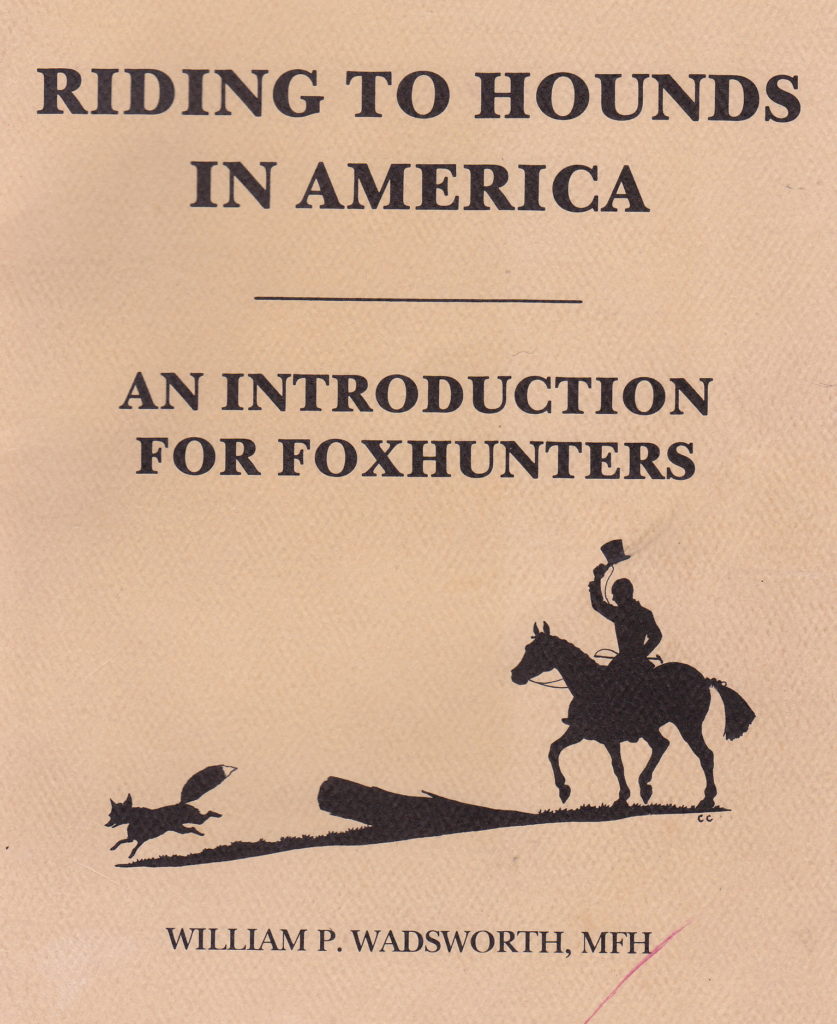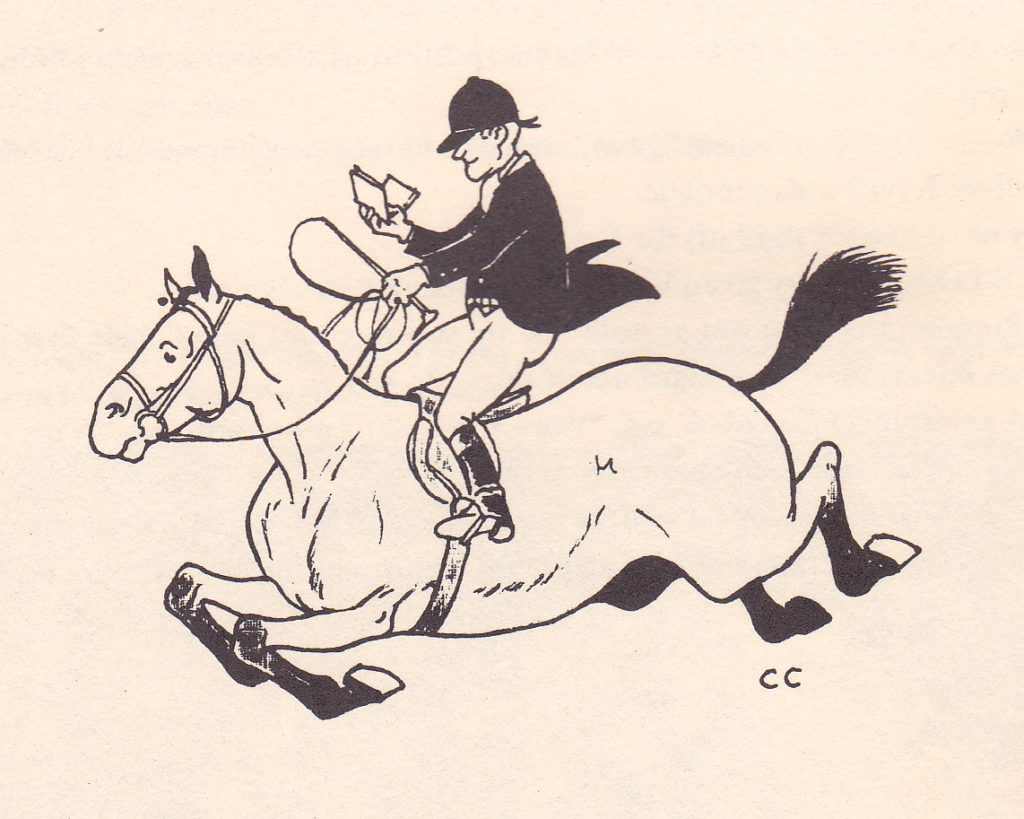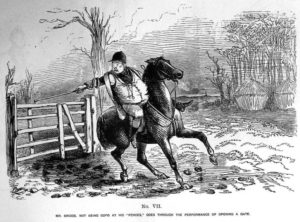
Have you ever recommended the classic primer Riding to Hounds in America to someone new to foxhunting? Written by William P. Wadsworth, MFH, and first published in 1962, it’s widely considered the essential introductory text about our sport. Now in its 19th printing, the original text has never been revised. The absence of any alterations suggests two possibilities: either Wadsworth’s pen flowed with such eternal infallibility that not one jot has become outdated in 55 years or, alternatively, no one who knows a damn thing about foxhunting today has actually read it since the Kennedy Administration.
To be sure, there’s much within those light beige covers still of inestimable value. But a few caveats would be in order before putting this pamphlet in the hands of the foxhunting “newbie.” A dozen or so citations of questionable applicability include the following:
“Cubhunting is purely the business of the master and the staff, and except by his express permission, no one else has a right to attend.” (Page 5)
“Remember that the most important gait in a hunter is the halt. If your horse won’t stand, teach him; if he won’t learn, sell him; if he won’t sell, shoot him.” (Page 6) [And to make sure he gets his point across, Wadsworth adds this farther on:] “If you cannot control your horse, train him or sell him. If your horse is a kicker, get rid of him or put him humanely down.” (Page 39)
“Never use a hunting whip or a bat to discipline a hunter. Use spurs instead, if necessary, and he will not be whip-shy.” (Page 7)
“Do not use a saddle cloth unless necessary…” (Page 7)
“On no account should you use rubber pads on your stirrups as they are most dangerous.” (Page 7)
“The running martingale can be most dangerous, and some hunts frown on its use. The standing martingale, properly adjusted, is considerably less dangerous.” (Page 8) [Wadsworth’s counsel still holds in the estimation of some. But others take the opposite view or have no preference either way.]
“Sandwich cases or flasks (never both) may be carried…” (Page 9) [Never both? You mean I’ve been violating a Wadsworth dictum all these years and no one has ever bothered to correct me?]

“…never wear a hunting cap without being sure the MFH approves. The cap is a symbol of authority, to be worn only by staff and other persons singled out by the MFH.” (Page 9) “Hat: Black…hunting bowler. (see Foreword p.2)” (Page 10) [Granted, in his Foreword to the 1987 printing, Peter Winants does state his belief that Wadsworth would have agreed that “harnesses for hunt caps are acceptable in the hunting field.” But no effort was made to revise the text beyond that parenthetical reference to the Foreword. And even that might still be read to suggest even a harness-equipped “hunt cap” is only for staff and everyone else should wear bowlers.]
“Breeches…should have buttons at the knee, not laces. They must fit well, so unless you are one in a million, they should be made to order.” (Page 10)
Under instructions for how to tie a stock: “Unless your shirt has buttons on the collar, front and rear, procure at least three (one is a spare) collar buttons (the longer type, designed for the front collar of a man’s dress shirt, is necessary in front and easier in the rear).” (Page 12) [Even at my advanced aged I’m not familiar with “collar buttons” for a “man’s dress shirt.” And I challenge anyone without an engineering degree to tie a proper stock by following Wadsworth instructions.]
“If you van, find a spot five or 10 minutes hacking time from the meet where there is room to unload and park without interfering with traffic or blocking someone’s driveway…” (Page 14) “Your van…has been parked clear of the paved or traveled part of the highway. (If you leave the ramp sticking out on the road, the users thereof will scream to the police, then the police will scream at the master. Guess who gets it next.) (Page 24)
Interspersed with these outdated, or at least questionable, bits of counsel are valuable passages of timeless advice. While some elements of turnout have changed (e.g., hunt caps as a mark of authority and buttons on the knees of tailor-made breeches) much has remained the same. Moreover, even back in ’62 Wadsworth recognized that while he considered hunting attire to be “rigidly conventional,” he conceded that “some hunts are much less conventional about what is expected of the field than others” and that “certain local customs have developed.” As such, he advised the novice to “consult with an experienced hunting person who is acquainted with what is expected of a newcomer to that particular hunt.” [I’m always amused by questions posted on Facebook asking about some element of turnout. The hunting traditionalist can pontificate till the hounds come home about what’s “correct,” but the simple answer is almost always, “Ask the leadership of the specific hunt.”]
Another passage worth reading is Wadsworth’s excellent definition of hunting etiquette: “Good manners may be defined as habitual consideration for the rights and feelings of other people with whom we come into contact. Hunting etiquette may be defined as the rules by which good manners may be best expressed under conditions prevailing in the hunting field.” (Page 35)
Most would likely agree that other Wadsworth citations on turnout and etiquette, such as the use of ladies’ hairnets (he was for them) and excessive “coffeehousing” (he was against it), are also still valid. But, again, even those could be considered within the purview of the particular hunt.
Yet despite all its outdated passages, Wadsworth’s booklet is still considered by many to be a must-read for anyone new to foxhunting. In reality, though, much of its message is likely to leave the “newbie” more confused than edified. If there’s one admonition worth following, it’s one already cited above, a bit of counsel that, if followed faithfully, will negate the need for any general purpose instruction manual: “consult with an experienced hunting person who is acquainted with what is expected of a newcomer to that particular hunt.”
On the upside, for the price ($6.00 at Horse Country), it makes an amusing addition to your foxhunting library. And if nothing else, the classic Custer Cassidy sketches are good for a chuckle.




